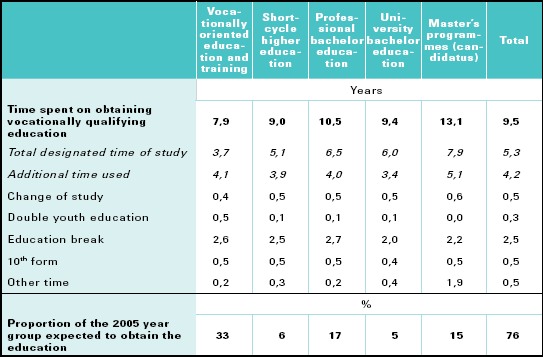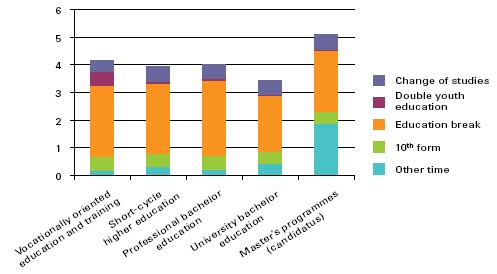
|

7 Time spent from completing the 9th form until achieving vocational qualificationsIn average, the Danes use 4.2 years more than the designated time to complete a vocationally qualifying education after graduating from the 9th form. Frequently, more time is used on obtaining a vocationally qualifying education than is stipulated for the particular course of study. This is because the students can change their choice of study, they can take breaks from the studies, and some choose to take more than one youth education. Table 7.1 shows the total time used by the students to obtain a vocationally qualifying education. The total designated duration of study corresponds to the straight course from 9th form graduation to the completion of a vocationally qualifying education. Designated time for a teacherís education is three years in general upper secondary school and four years in a teacherís training college, a total of seven years6. This is not the only course to a teacherís education; however, it is the most direct one. Furthermore, the additional time used by the students completing the 9th form is shown. The additional time comprises: 1) change of studies, referring to the time used on a course of study not completed, 2) double youth education, meaning the time used on another youth education after having completed one youth education, 3) an education break, referring to the time not used for education, for instance for work, military service, travelling etc., 4) 10th form since the 10th form is optional, and 5) other time, mainly covering an extended time to complete the study programme. In average, a student uses 9.5 years after the 9th form to obtain an education. Of these, 5.3 years are used on the designated time of studies and 4.2 years on additional time. The largest part of the additional time is used on an education break of 2.5 years. In average, change of studies, 10th form, and other time each constitute 0.5 years, and a double youth education adds 0.3 years. The average time used on changing study and on 10th form are practically independent of which education is taken, whilst other types of time used vary depending on education programme. The longest education break is found in vocationally oriented education and training programmes, short-cycle higher education, and professional bachelor education, while the university students take the shortest breaks. In the vocationally oriented education and training programmes, an average of 3.7 years is used on designated time of study. An additional 4.1 years are used on completing the education. A double youth education is naturally most common in the trade programmes because many choose to take a general upper secondary as well as a vocationally oriented education and training. With 3.4 years, the university bachelors have the least extra use of time. Here, the break in education is also the shortest. Note that only students who do not continue in a masterís programme (candidatus) are counted here. The majority by far continues in a masterís programme (candidatus), and they are therefore counted in that category. With 5.1 years, the masterís students (candidatus) have the highest use of extra time. Their break in education is less than average; however, other time, mainly consisting of study delays, being almost two years in average, is much higher than in other education programmes. Figure 7.1 depicts the additional time used by the students to obtain vocational qualifications. Table 7.1. Time spent from completing the 9th form until achieving vocational qualifications
Figure 7.1. Additional time spent by students to attain vocational qualifications, years
Footnotes6) In practice, a little less than seven years because most programmes start in August/September and terminate in June.
|
||
|
To the top of the page |

